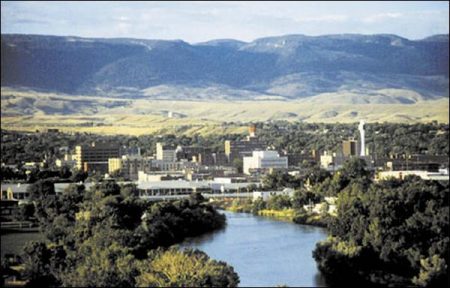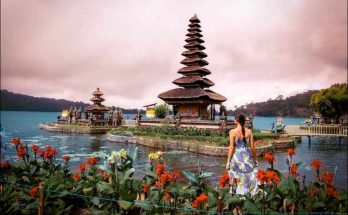Casper (5,123 alt., 49,644 pop.), seat of Natrona County and second largest city in Wyoming, lies in a great bend on the south side of the North Platte River; south of the town the pine-studded slopes of Casper Mountain rise to an altitude of more than 8,000 feet.
An industrialized cow-town, Casper retains many characteristics of its youth. Ranch hands of the old C Y outfit, whose pastures once included present Casper, still work cattle and make hay almost within the shadows of oil refineries and storage tanks. Sage chickens scuttle between clumps of sage and rabbit brush on the outskirts of the city, and residents drive out to the flats to watch the cocks parade during the mating season in the spring.
Log cabins and derelict frame buildings still shoulder against newer brick structures. Residential additions extend Old Casper on the south, east, and north, and unimproved plots within the additions suggest the tempestuous nature of Casper’s growth. Its streets are wide, and many are bordered with sentinel rows of cottonwoods and poplars. Newer residences in the southern sector are of Georgian colonial style, with brick walls, circular porticoes, and wrought-iron balconies. The Standard Addition, southwest of the original townsite, has several hundred houses of modified Spanish mission design.
Casper’s central location in Wyoming has contributed much to its development as an industrial and commercial center. Its basic industry is oil, but its geographic location at the juncture of four national highways and two mainline railroads has made it the distribution point for a wide trade area. Trucks loaded with casing and cables lumber through the city to near-by oil fields. Freight is piled high at the depot yards for transportation to rural areas or reclamation projects in the Casper trade zone. The silver Mainliners of Inland Air Lines fly north and south from their Casper headquarters; the drone of their motors rises above the hum of city activity as they gain altitude or circle into the landing headwind.
Casper’s outstanding annual event is Wyoming-on-Parade, during the third week in August. The feature is a parade that reproduces scenes from the city’s and State’s frontier days, and the subsequent progress and development. Of unusual interest is the jerkline freight team of 16 horses harnessed to three old freight wagons and driven by bona-fide ‘mule skinners.’ Legendary frontier characters are revived and uniformed bands, National Guard cavalry units, and gaudily clad cowboys and cowgirls complete the procession.
The Platte River Valley provided the most satisfactory wagon route westward during the 1840’s and 1850’s, and an estimated 300,000 persons followed the Oregon Trail across what is now the townsite of Casper before wagon traffic was rerouted over the southern Overland Trail in the 1860’s. The first white men known to pass through the region were Robert Stuart’s Astorians, who trekked through central Wyoming in 1812, en route to St. Louis from Astor’s Pacific Coast trading post. The exploring parties of Bonneville and Frémont followed, and in 1842 Elijah White’s prairie schooners were rolling along the Platte.
Views: 3688



